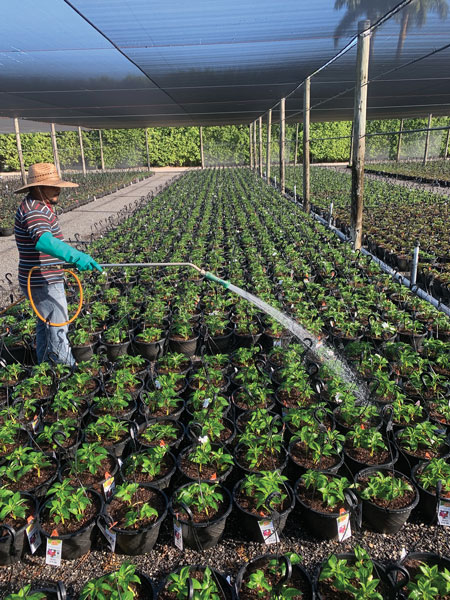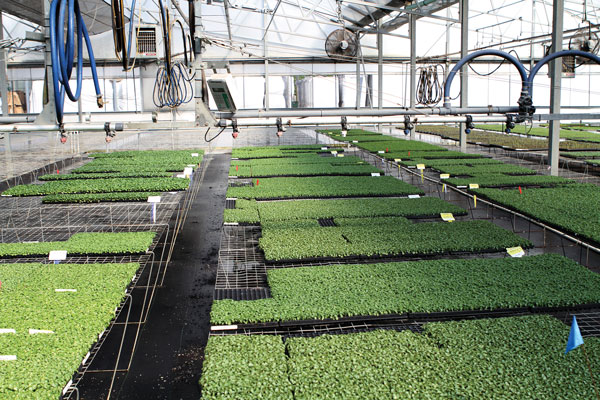7/1/2019
Important Considerations to Deliver Healthy Plants
Dr. Aaron Palmateer

Cultivating high-quality plants without aesthetic injury is no easy feat for ornamental greenhouse and nursery growers. Ultimately, plant protection products are critical to help growers succeed in growing healthy, beautiful plants. Pesticides are an essential tool for pest and disease management, but need to be used appropriately to perform at their best.
Pictured: A grower uses a hand-held sprayer to manage a foliar application of Altus.
First and foremost, always refer to and follow the manufacturer’s label before applying. From there, below are some additional considerations to help you get the most out of your pesticide application.
• Use available resources to choose the best solution. This includes selecting products currently registered for use in your state and county that are labeled to control the identified pest or pathogen. When questions arise, there are important resources, such as university extension faculty, county extension agents and diagnostic labs available for consultation. In addition, manufacturers such as Bayer are always willing to assist growers with finding solutions. Obtaining a proper diagnosis and consulting experts can save time and money when it comes to controlling pests and diseases.
• Consider the application method. Larger commercial greenhouse operations often have automated boom sprayers mounted over the top of crops, while many growers are using hand-held sprayers for pesticide applications. Regardless of the application method, it’s critical that the product is applied where needed, which is dependent on the formulation and behavior of the active ingredient. Understanding how a product works will help determine the most appropriate application method.
• Make an informed decision about whether to use a systemic or non-systemic product. Non-systemic products need to contact the intended plant tissue (i.e., roots, stems, branches, leaves and flowers) in order to provide protection. Some products provide translaminar
protection, which means the treatment moves throughout the leaf to protect both the upper and lower leaf surface where many pests and pathogens are hiding. Systemic products are most often applied as drench or sprench applications, contacting the roots for uptake and subsequent movement upward in the xylem into above-ground portions of the plant.
 Pictured: Many larger greenhouse operations install boom sprayers for automated pesticide application.
Pictured: Many larger greenhouse operations install boom sprayers for automated pesticide application.
Some products, such as the fungicide Aliette or the insecticide Kontos, are truly systemic, meaning that they move into the sieve tubes of the plant phloem and transport upwards or downwards to all parts of the plant, including the roots. Because systemic products move into the plant tissue, they tend to provide longer protection than those that remain on the outer plant tissue, such as non-systemic pesticides. However, when dealing with existing infestations, some non-systemic pesticides may be faster acting. Growers should consider how different products work for greatest success managing insects and diseases.
• Applicators should always refer to the product label for mixing instructions, application rates and intervals. A product’s application rates and intervals are important considerations when determining efficacy and cost-in-use. Some systemic products may provide longer protection, requiring fewer applications and, ultimately, save growers time and labor.
Throughout the growing process, it’s also important to understand when and where growers can apply a product. For example, Altus insecticide can be applied anytime throughout the production cycle (before, during and after bloom) with a four-hour REI as a foliar spray or zero-hour REI when drenched, which gives growers a flexible and effective solution throughout the growing season.
At the end of the day, it’s generally best to apply pesticides preventatively to adequately control plant pests, diseases and weeds before they occur. Be sure to account for the time of sale, so that the plants have lasting protection during transportation or while sitting on shelves at the retail store. Growers will be able to rest easy knowing consumers will bring home beautiful and healthy plants. GT
Aaron Palmateer, Ph.D. is a Senior Technical Support Representative for Bayer.